PROJ6000: Project Management Principles, Methods, and Documents
VerifiedAdded on 2022/09/03
|11
|2385
|28
Report
AI Summary
This report delves into the principles of project management, emphasizing the importance of structuring, planning, and controlling projects to achieve specific goals. It outlines six key principles: vision and mission, business goals, standards of engagement, intervention and implementing strategy, organizational alignment, and accountability and measurement. The report uses a construction project as a case study, focusing on the Project Management Body of Knowledge (PMBOK) and best practices to improve operations, reduce costs, and increase efficiency. It discusses the project management process, including initiating, planning, executing, monitoring and controlling, and closing, along with the ten knowledge areas such as scope, time, cost, quality, and risk. The report also examines the PMI's Code of Ethics, risk management in construction projects, various types of risks such as safety, technical, logistical, and environmental risks, and the techniques used to mitigate these risks, including BIM and Big Data. The report concludes by highlighting the essential documents and procedures required for effective project management and emphasizes the importance of understanding the different phases of a project to ensure successful outcomes.
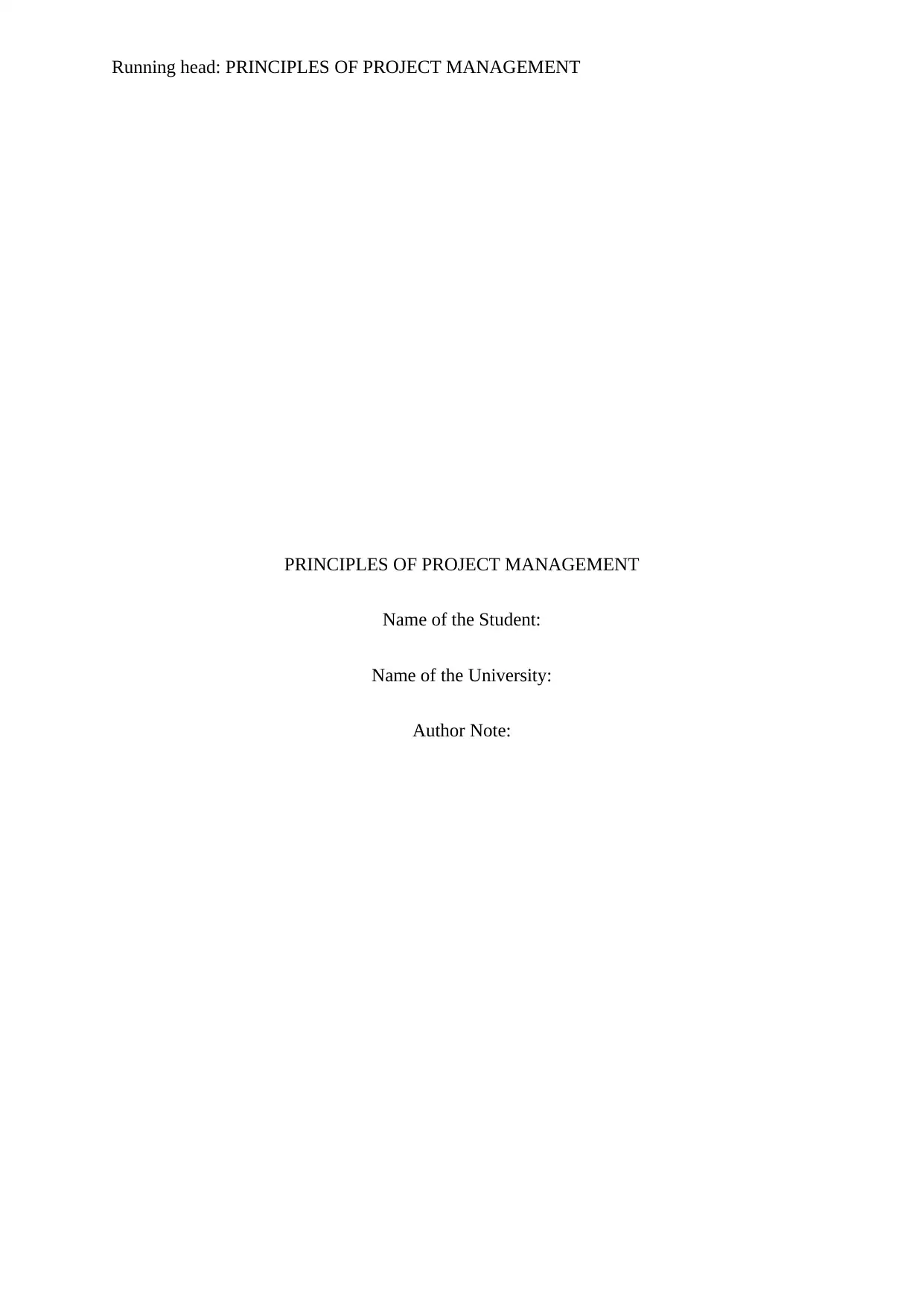
Running head: PRINCIPLES OF PROJECT MANAGEMENT
PRINCIPLES OF PROJECT MANAGEMENT
Name of the Student:
Name of the University:
Author Note:
PRINCIPLES OF PROJECT MANAGEMENT
Name of the Student:
Name of the University:
Author Note:
Paraphrase This Document
Need a fresh take? Get an instant paraphrase of this document with our AI Paraphraser
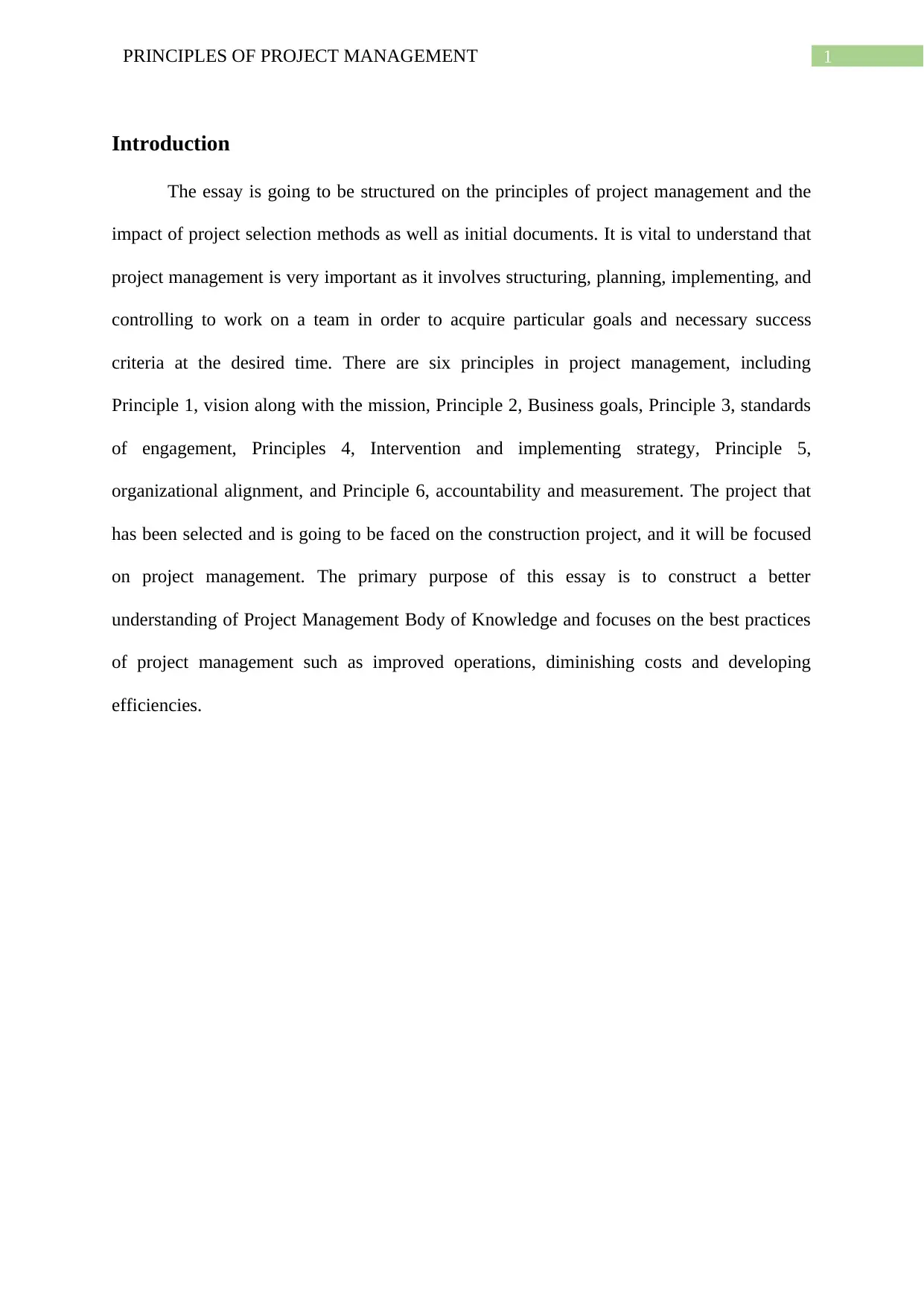
1PRINCIPLES OF PROJECT MANAGEMENT
Introduction
The essay is going to be structured on the principles of project management and the
impact of project selection methods as well as initial documents. It is vital to understand that
project management is very important as it involves structuring, planning, implementing, and
controlling to work on a team in order to acquire particular goals and necessary success
criteria at the desired time. There are six principles in project management, including
Principle 1, vision along with the mission, Principle 2, Business goals, Principle 3, standards
of engagement, Principles 4, Intervention and implementing strategy, Principle 5,
organizational alignment, and Principle 6, accountability and measurement. The project that
has been selected and is going to be faced on the construction project, and it will be focused
on project management. The primary purpose of this essay is to construct a better
understanding of Project Management Body of Knowledge and focuses on the best practices
of project management such as improved operations, diminishing costs and developing
efficiencies.
Introduction
The essay is going to be structured on the principles of project management and the
impact of project selection methods as well as initial documents. It is vital to understand that
project management is very important as it involves structuring, planning, implementing, and
controlling to work on a team in order to acquire particular goals and necessary success
criteria at the desired time. There are six principles in project management, including
Principle 1, vision along with the mission, Principle 2, Business goals, Principle 3, standards
of engagement, Principles 4, Intervention and implementing strategy, Principle 5,
organizational alignment, and Principle 6, accountability and measurement. The project that
has been selected and is going to be faced on the construction project, and it will be focused
on project management. The primary purpose of this essay is to construct a better
understanding of Project Management Body of Knowledge and focuses on the best practices
of project management such as improved operations, diminishing costs and developing
efficiencies.
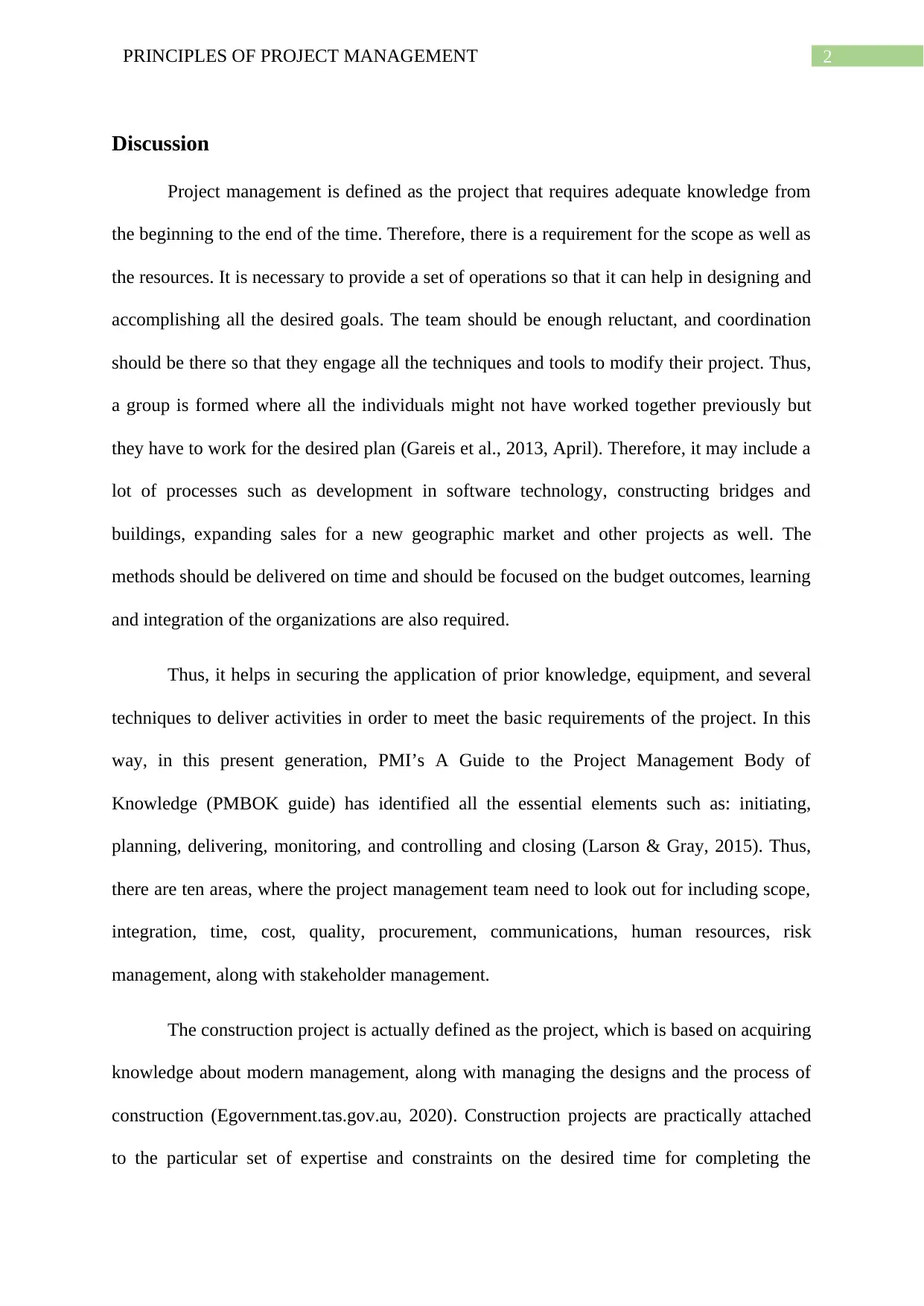
2PRINCIPLES OF PROJECT MANAGEMENT
Discussion
Project management is defined as the project that requires adequate knowledge from
the beginning to the end of the time. Therefore, there is a requirement for the scope as well as
the resources. It is necessary to provide a set of operations so that it can help in designing and
accomplishing all the desired goals. The team should be enough reluctant, and coordination
should be there so that they engage all the techniques and tools to modify their project. Thus,
a group is formed where all the individuals might not have worked together previously but
they have to work for the desired plan (Gareis et al., 2013, April). Therefore, it may include a
lot of processes such as development in software technology, constructing bridges and
buildings, expanding sales for a new geographic market and other projects as well. The
methods should be delivered on time and should be focused on the budget outcomes, learning
and integration of the organizations are also required.
Thus, it helps in securing the application of prior knowledge, equipment, and several
techniques to deliver activities in order to meet the basic requirements of the project. In this
way, in this present generation, PMI’s A Guide to the Project Management Body of
Knowledge (PMBOK guide) has identified all the essential elements such as: initiating,
planning, delivering, monitoring, and controlling and closing (Larson & Gray, 2015). Thus,
there are ten areas, where the project management team need to look out for including scope,
integration, time, cost, quality, procurement, communications, human resources, risk
management, along with stakeholder management.
The construction project is actually defined as the project, which is based on acquiring
knowledge about modern management, along with managing the designs and the process of
construction (Egovernment.tas.gov.au, 2020). Construction projects are practically attached
to the particular set of expertise and constraints on the desired time for completing the
Discussion
Project management is defined as the project that requires adequate knowledge from
the beginning to the end of the time. Therefore, there is a requirement for the scope as well as
the resources. It is necessary to provide a set of operations so that it can help in designing and
accomplishing all the desired goals. The team should be enough reluctant, and coordination
should be there so that they engage all the techniques and tools to modify their project. Thus,
a group is formed where all the individuals might not have worked together previously but
they have to work for the desired plan (Gareis et al., 2013, April). Therefore, it may include a
lot of processes such as development in software technology, constructing bridges and
buildings, expanding sales for a new geographic market and other projects as well. The
methods should be delivered on time and should be focused on the budget outcomes, learning
and integration of the organizations are also required.
Thus, it helps in securing the application of prior knowledge, equipment, and several
techniques to deliver activities in order to meet the basic requirements of the project. In this
way, in this present generation, PMI’s A Guide to the Project Management Body of
Knowledge (PMBOK guide) has identified all the essential elements such as: initiating,
planning, delivering, monitoring, and controlling and closing (Larson & Gray, 2015). Thus,
there are ten areas, where the project management team need to look out for including scope,
integration, time, cost, quality, procurement, communications, human resources, risk
management, along with stakeholder management.
The construction project is actually defined as the project, which is based on acquiring
knowledge about modern management, along with managing the designs and the process of
construction (Egovernment.tas.gov.au, 2020). Construction projects are practically attached
to the particular set of expertise and constraints on the desired time for completing the
⊘ This is a preview!⊘
Do you want full access?
Subscribe today to unlock all pages.

Trusted by 1+ million students worldwide
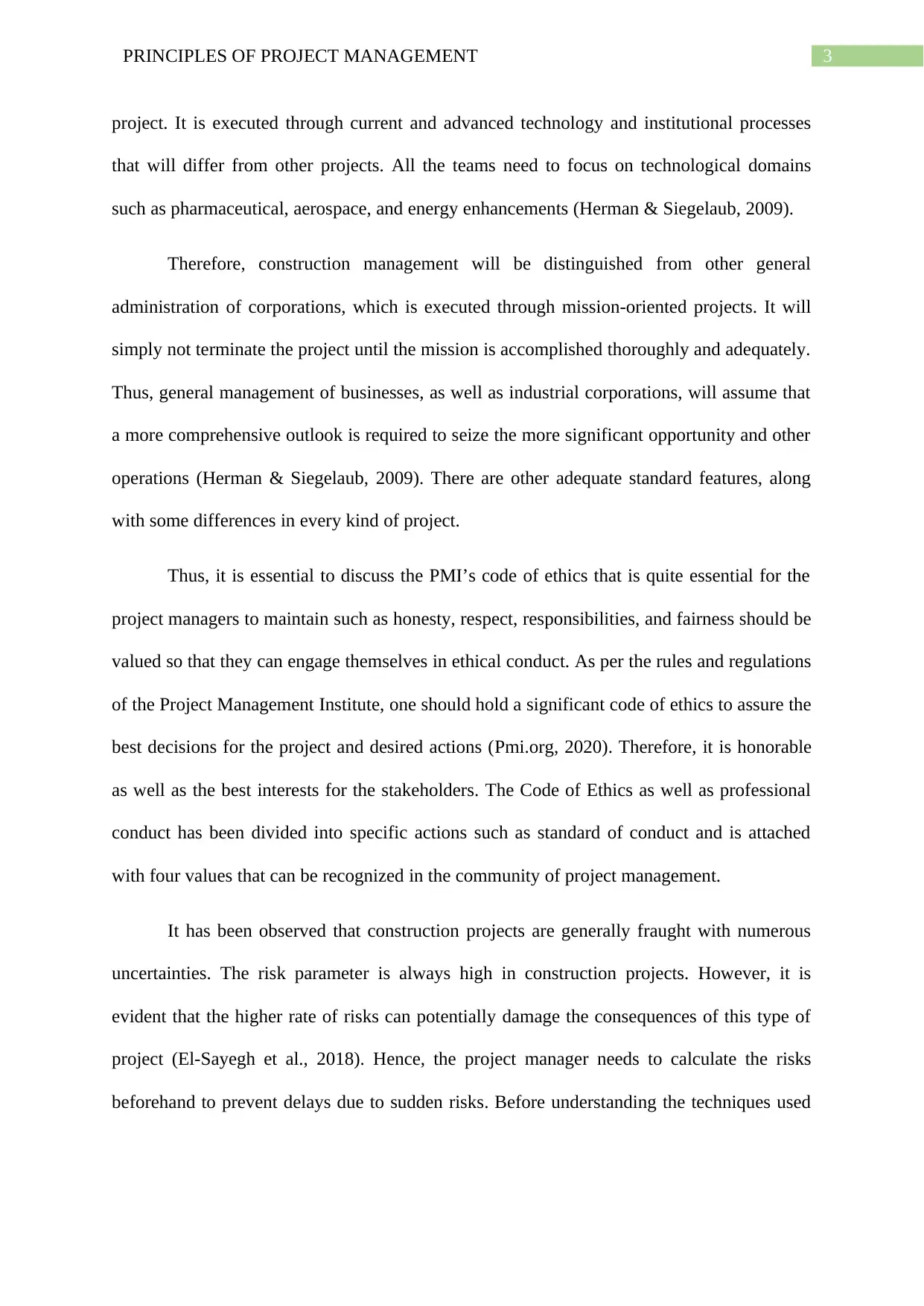
3PRINCIPLES OF PROJECT MANAGEMENT
project. It is executed through current and advanced technology and institutional processes
that will differ from other projects. All the teams need to focus on technological domains
such as pharmaceutical, aerospace, and energy enhancements (Herman & Siegelaub, 2009).
Therefore, construction management will be distinguished from other general
administration of corporations, which is executed through mission-oriented projects. It will
simply not terminate the project until the mission is accomplished thoroughly and adequately.
Thus, general management of businesses, as well as industrial corporations, will assume that
a more comprehensive outlook is required to seize the more significant opportunity and other
operations (Herman & Siegelaub, 2009). There are other adequate standard features, along
with some differences in every kind of project.
Thus, it is essential to discuss the PMI’s code of ethics that is quite essential for the
project managers to maintain such as honesty, respect, responsibilities, and fairness should be
valued so that they can engage themselves in ethical conduct. As per the rules and regulations
of the Project Management Institute, one should hold a significant code of ethics to assure the
best decisions for the project and desired actions (Pmi.org, 2020). Therefore, it is honorable
as well as the best interests for the stakeholders. The Code of Ethics as well as professional
conduct has been divided into specific actions such as standard of conduct and is attached
with four values that can be recognized in the community of project management.
It has been observed that construction projects are generally fraught with numerous
uncertainties. The risk parameter is always high in construction projects. However, it is
evident that the higher rate of risks can potentially damage the consequences of this type of
project (El-Sayegh et al., 2018). Hence, the project manager needs to calculate the risks
beforehand to prevent delays due to sudden risks. Before understanding the techniques used
project. It is executed through current and advanced technology and institutional processes
that will differ from other projects. All the teams need to focus on technological domains
such as pharmaceutical, aerospace, and energy enhancements (Herman & Siegelaub, 2009).
Therefore, construction management will be distinguished from other general
administration of corporations, which is executed through mission-oriented projects. It will
simply not terminate the project until the mission is accomplished thoroughly and adequately.
Thus, general management of businesses, as well as industrial corporations, will assume that
a more comprehensive outlook is required to seize the more significant opportunity and other
operations (Herman & Siegelaub, 2009). There are other adequate standard features, along
with some differences in every kind of project.
Thus, it is essential to discuss the PMI’s code of ethics that is quite essential for the
project managers to maintain such as honesty, respect, responsibilities, and fairness should be
valued so that they can engage themselves in ethical conduct. As per the rules and regulations
of the Project Management Institute, one should hold a significant code of ethics to assure the
best decisions for the project and desired actions (Pmi.org, 2020). Therefore, it is honorable
as well as the best interests for the stakeholders. The Code of Ethics as well as professional
conduct has been divided into specific actions such as standard of conduct and is attached
with four values that can be recognized in the community of project management.
It has been observed that construction projects are generally fraught with numerous
uncertainties. The risk parameter is always high in construction projects. However, it is
evident that the higher rate of risks can potentially damage the consequences of this type of
project (El-Sayegh et al., 2018). Hence, the project manager needs to calculate the risks
beforehand to prevent delays due to sudden risks. Before understanding the techniques used
Paraphrase This Document
Need a fresh take? Get an instant paraphrase of this document with our AI Paraphraser
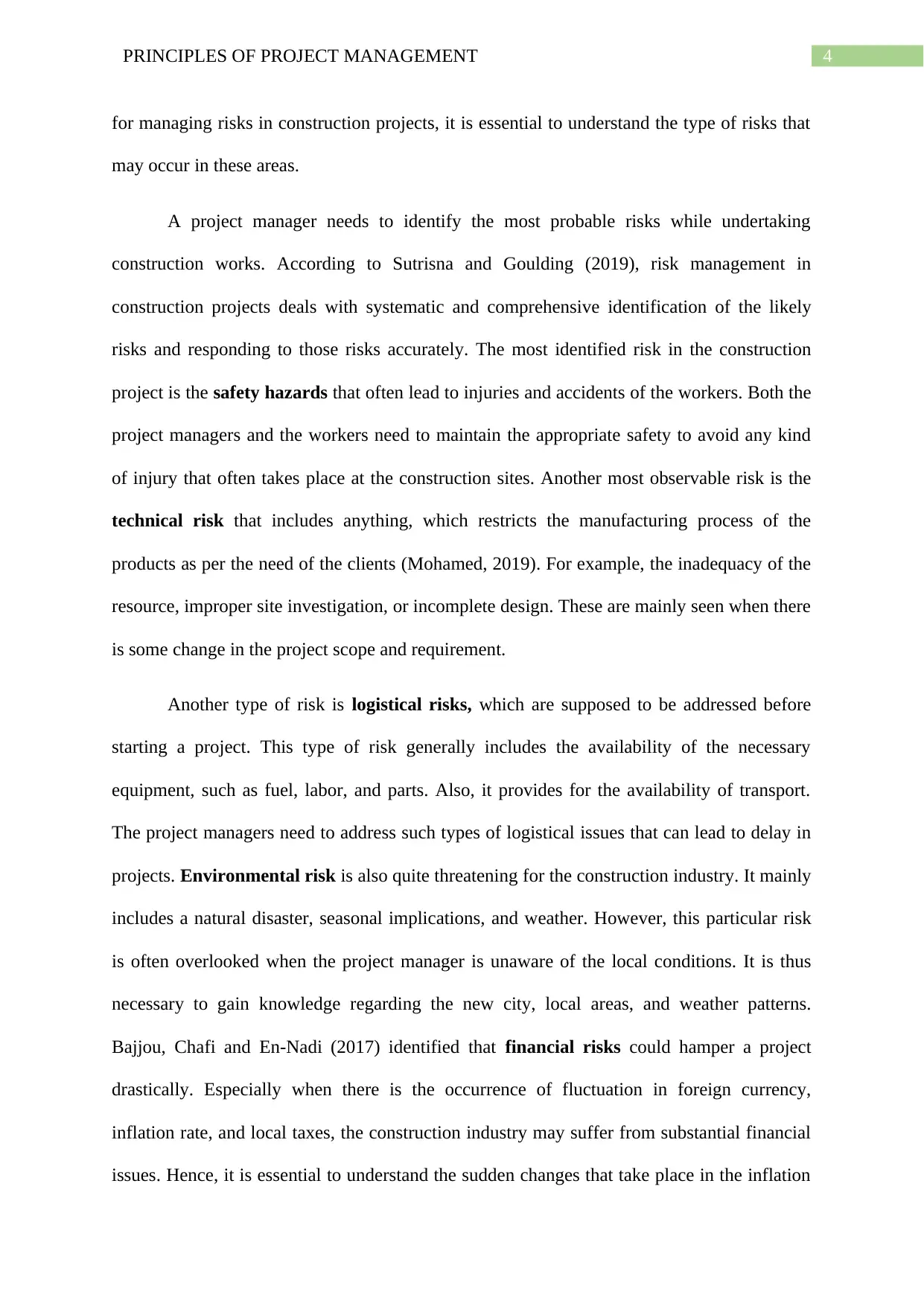
4PRINCIPLES OF PROJECT MANAGEMENT
for managing risks in construction projects, it is essential to understand the type of risks that
may occur in these areas.
A project manager needs to identify the most probable risks while undertaking
construction works. According to Sutrisna and Goulding (2019), risk management in
construction projects deals with systematic and comprehensive identification of the likely
risks and responding to those risks accurately. The most identified risk in the construction
project is the safety hazards that often lead to injuries and accidents of the workers. Both the
project managers and the workers need to maintain the appropriate safety to avoid any kind
of injury that often takes place at the construction sites. Another most observable risk is the
technical risk that includes anything, which restricts the manufacturing process of the
products as per the need of the clients (Mohamed, 2019). For example, the inadequacy of the
resource, improper site investigation, or incomplete design. These are mainly seen when there
is some change in the project scope and requirement.
Another type of risk is logistical risks, which are supposed to be addressed before
starting a project. This type of risk generally includes the availability of the necessary
equipment, such as fuel, labor, and parts. Also, it provides for the availability of transport.
The project managers need to address such types of logistical issues that can lead to delay in
projects. Environmental risk is also quite threatening for the construction industry. It mainly
includes a natural disaster, seasonal implications, and weather. However, this particular risk
is often overlooked when the project manager is unaware of the local conditions. It is thus
necessary to gain knowledge regarding the new city, local areas, and weather patterns.
Bajjou, Chafi and En-Nadi (2017) identified that financial risks could hamper a project
drastically. Especially when there is the occurrence of fluctuation in foreign currency,
inflation rate, and local taxes, the construction industry may suffer from substantial financial
issues. Hence, it is essential to understand the sudden changes that take place in the inflation
for managing risks in construction projects, it is essential to understand the type of risks that
may occur in these areas.
A project manager needs to identify the most probable risks while undertaking
construction works. According to Sutrisna and Goulding (2019), risk management in
construction projects deals with systematic and comprehensive identification of the likely
risks and responding to those risks accurately. The most identified risk in the construction
project is the safety hazards that often lead to injuries and accidents of the workers. Both the
project managers and the workers need to maintain the appropriate safety to avoid any kind
of injury that often takes place at the construction sites. Another most observable risk is the
technical risk that includes anything, which restricts the manufacturing process of the
products as per the need of the clients (Mohamed, 2019). For example, the inadequacy of the
resource, improper site investigation, or incomplete design. These are mainly seen when there
is some change in the project scope and requirement.
Another type of risk is logistical risks, which are supposed to be addressed before
starting a project. This type of risk generally includes the availability of the necessary
equipment, such as fuel, labor, and parts. Also, it provides for the availability of transport.
The project managers need to address such types of logistical issues that can lead to delay in
projects. Environmental risk is also quite threatening for the construction industry. It mainly
includes a natural disaster, seasonal implications, and weather. However, this particular risk
is often overlooked when the project manager is unaware of the local conditions. It is thus
necessary to gain knowledge regarding the new city, local areas, and weather patterns.
Bajjou, Chafi and En-Nadi (2017) identified that financial risks could hamper a project
drastically. Especially when there is the occurrence of fluctuation in foreign currency,
inflation rate, and local taxes, the construction industry may suffer from substantial financial
issues. Hence, it is essential to understand the sudden changes that take place in the inflation
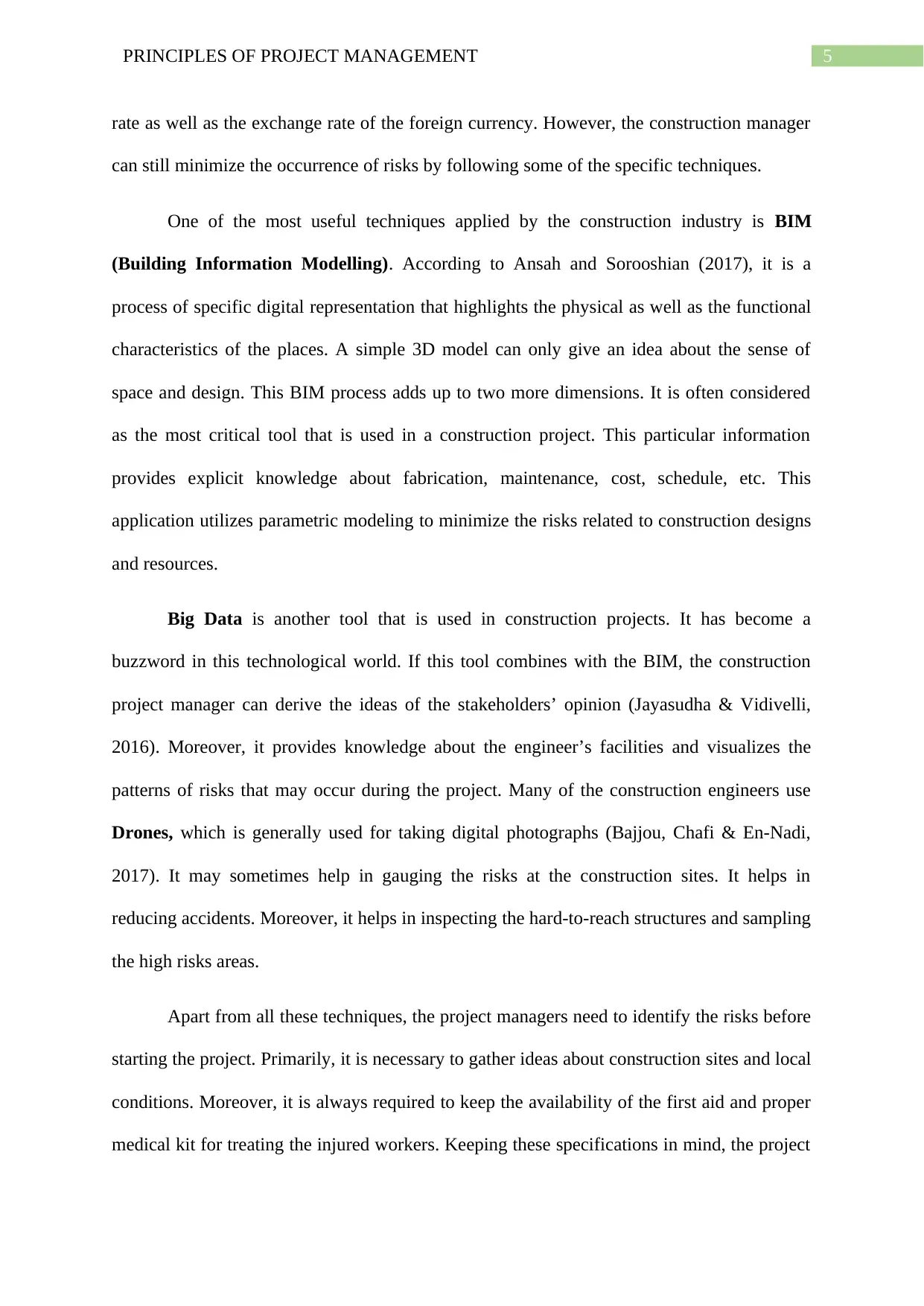
5PRINCIPLES OF PROJECT MANAGEMENT
rate as well as the exchange rate of the foreign currency. However, the construction manager
can still minimize the occurrence of risks by following some of the specific techniques.
One of the most useful techniques applied by the construction industry is BIM
(Building Information Modelling). According to Ansah and Sorooshian (2017), it is a
process of specific digital representation that highlights the physical as well as the functional
characteristics of the places. A simple 3D model can only give an idea about the sense of
space and design. This BIM process adds up to two more dimensions. It is often considered
as the most critical tool that is used in a construction project. This particular information
provides explicit knowledge about fabrication, maintenance, cost, schedule, etc. This
application utilizes parametric modeling to minimize the risks related to construction designs
and resources.
Big Data is another tool that is used in construction projects. It has become a
buzzword in this technological world. If this tool combines with the BIM, the construction
project manager can derive the ideas of the stakeholders’ opinion (Jayasudha & Vidivelli,
2016). Moreover, it provides knowledge about the engineer’s facilities and visualizes the
patterns of risks that may occur during the project. Many of the construction engineers use
Drones, which is generally used for taking digital photographs (Bajjou, Chafi & En-Nadi,
2017). It may sometimes help in gauging the risks at the construction sites. It helps in
reducing accidents. Moreover, it helps in inspecting the hard-to-reach structures and sampling
the high risks areas.
Apart from all these techniques, the project managers need to identify the risks before
starting the project. Primarily, it is necessary to gather ideas about construction sites and local
conditions. Moreover, it is always required to keep the availability of the first aid and proper
medical kit for treating the injured workers. Keeping these specifications in mind, the project
rate as well as the exchange rate of the foreign currency. However, the construction manager
can still minimize the occurrence of risks by following some of the specific techniques.
One of the most useful techniques applied by the construction industry is BIM
(Building Information Modelling). According to Ansah and Sorooshian (2017), it is a
process of specific digital representation that highlights the physical as well as the functional
characteristics of the places. A simple 3D model can only give an idea about the sense of
space and design. This BIM process adds up to two more dimensions. It is often considered
as the most critical tool that is used in a construction project. This particular information
provides explicit knowledge about fabrication, maintenance, cost, schedule, etc. This
application utilizes parametric modeling to minimize the risks related to construction designs
and resources.
Big Data is another tool that is used in construction projects. It has become a
buzzword in this technological world. If this tool combines with the BIM, the construction
project manager can derive the ideas of the stakeholders’ opinion (Jayasudha & Vidivelli,
2016). Moreover, it provides knowledge about the engineer’s facilities and visualizes the
patterns of risks that may occur during the project. Many of the construction engineers use
Drones, which is generally used for taking digital photographs (Bajjou, Chafi & En-Nadi,
2017). It may sometimes help in gauging the risks at the construction sites. It helps in
reducing accidents. Moreover, it helps in inspecting the hard-to-reach structures and sampling
the high risks areas.
Apart from all these techniques, the project managers need to identify the risks before
starting the project. Primarily, it is necessary to gather ideas about construction sites and local
conditions. Moreover, it is always required to keep the availability of the first aid and proper
medical kit for treating the injured workers. Keeping these specifications in mind, the project
⊘ This is a preview!⊘
Do you want full access?
Subscribe today to unlock all pages.

Trusted by 1+ million students worldwide
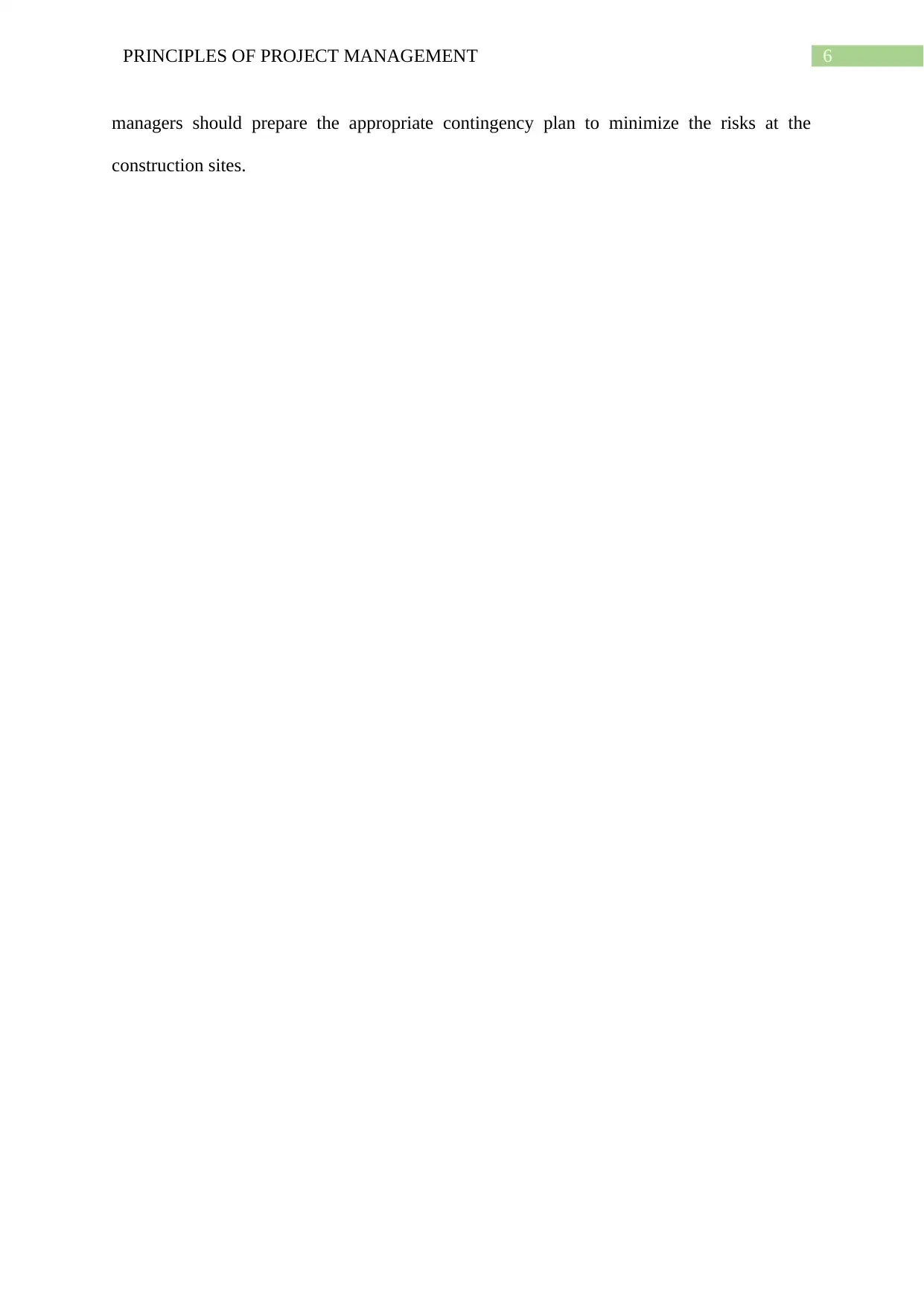
6PRINCIPLES OF PROJECT MANAGEMENT
managers should prepare the appropriate contingency plan to minimize the risks at the
construction sites.
managers should prepare the appropriate contingency plan to minimize the risks at the
construction sites.
Paraphrase This Document
Need a fresh take? Get an instant paraphrase of this document with our AI Paraphraser
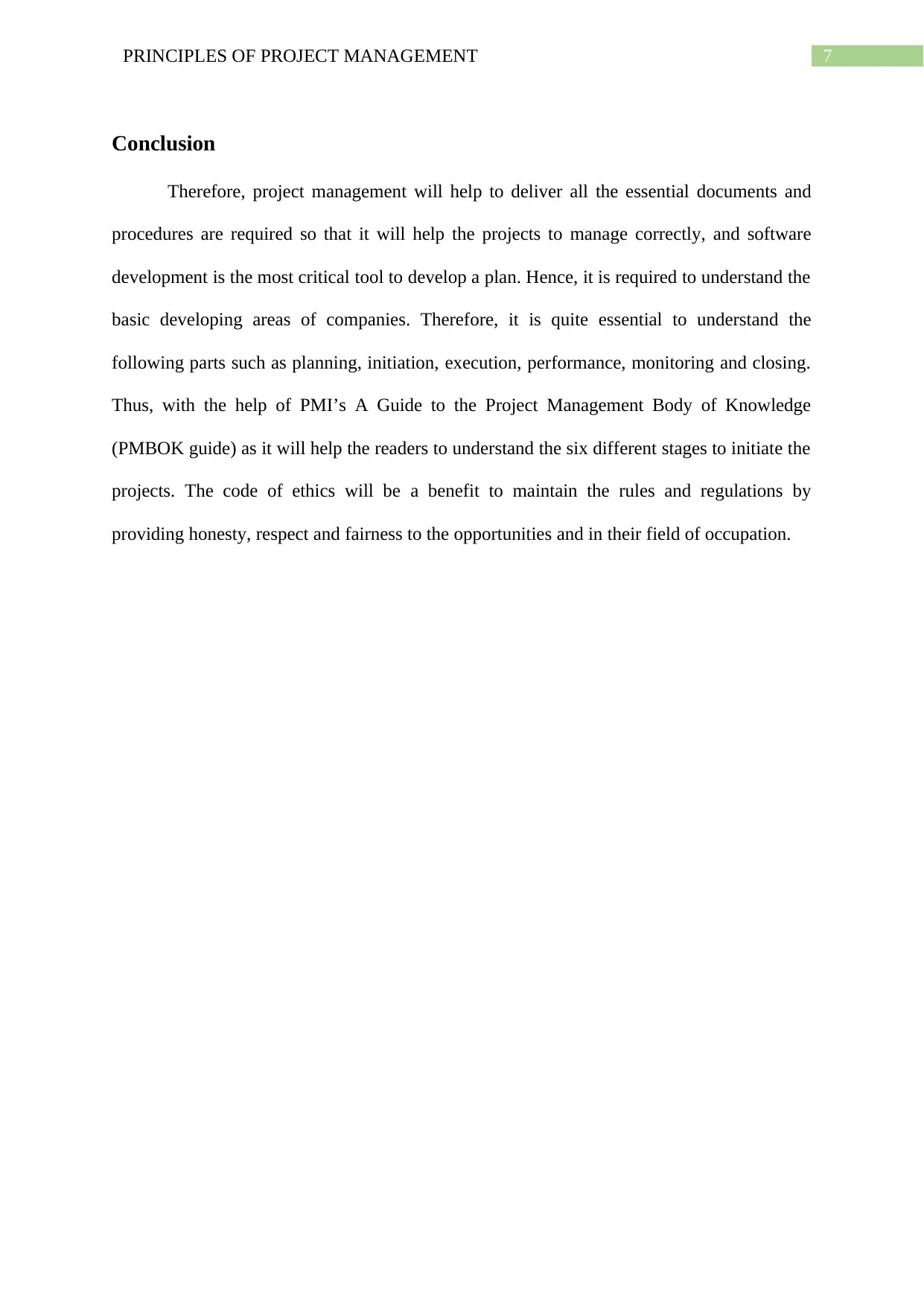
7PRINCIPLES OF PROJECT MANAGEMENT
Conclusion
Therefore, project management will help to deliver all the essential documents and
procedures are required so that it will help the projects to manage correctly, and software
development is the most critical tool to develop a plan. Hence, it is required to understand the
basic developing areas of companies. Therefore, it is quite essential to understand the
following parts such as planning, initiation, execution, performance, monitoring and closing.
Thus, with the help of PMI’s A Guide to the Project Management Body of Knowledge
(PMBOK guide) as it will help the readers to understand the six different stages to initiate the
projects. The code of ethics will be a benefit to maintain the rules and regulations by
providing honesty, respect and fairness to the opportunities and in their field of occupation.
Conclusion
Therefore, project management will help to deliver all the essential documents and
procedures are required so that it will help the projects to manage correctly, and software
development is the most critical tool to develop a plan. Hence, it is required to understand the
basic developing areas of companies. Therefore, it is quite essential to understand the
following parts such as planning, initiation, execution, performance, monitoring and closing.
Thus, with the help of PMI’s A Guide to the Project Management Body of Knowledge
(PMBOK guide) as it will help the readers to understand the six different stages to initiate the
projects. The code of ethics will be a benefit to maintain the rules and regulations by
providing honesty, respect and fairness to the opportunities and in their field of occupation.
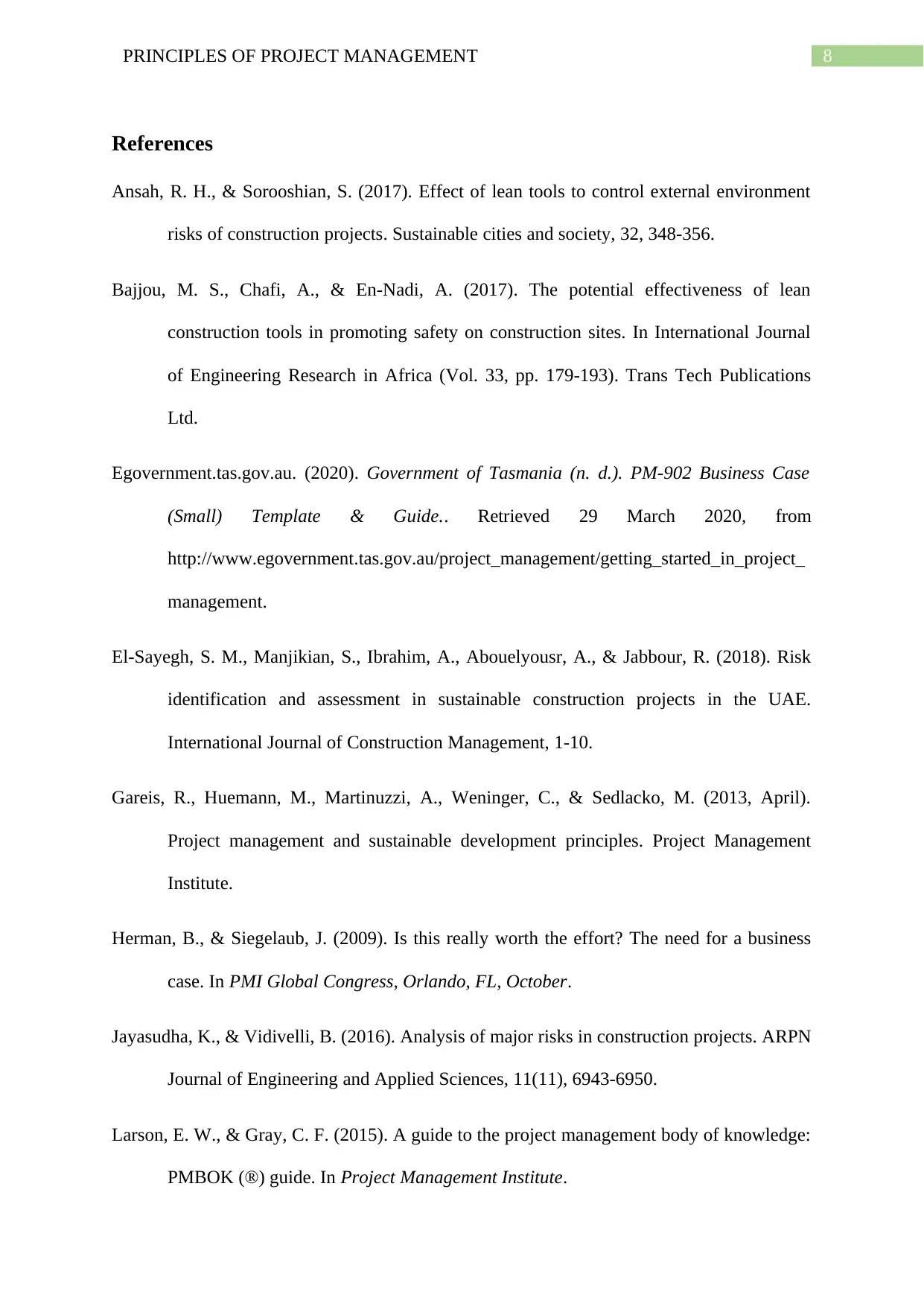
8PRINCIPLES OF PROJECT MANAGEMENT
References
Ansah, R. H., & Sorooshian, S. (2017). Effect of lean tools to control external environment
risks of construction projects. Sustainable cities and society, 32, 348-356.
Bajjou, M. S., Chafi, A., & En-Nadi, A. (2017). The potential effectiveness of lean
construction tools in promoting safety on construction sites. In International Journal
of Engineering Research in Africa (Vol. 33, pp. 179-193). Trans Tech Publications
Ltd.
Egovernment.tas.gov.au. (2020). Government of Tasmania (n. d.). PM-902 Business Case
(Small) Template & Guide.. Retrieved 29 March 2020, from
http://www.egovernment.tas.gov.au/project_management/getting_started_in_project_
management.
El-Sayegh, S. M., Manjikian, S., Ibrahim, A., Abouelyousr, A., & Jabbour, R. (2018). Risk
identification and assessment in sustainable construction projects in the UAE.
International Journal of Construction Management, 1-10.
Gareis, R., Huemann, M., Martinuzzi, A., Weninger, C., & Sedlacko, M. (2013, April).
Project management and sustainable development principles. Project Management
Institute.
Herman, B., & Siegelaub, J. (2009). Is this really worth the effort? The need for a business
case. In PMI Global Congress, Orlando, FL, October.
Jayasudha, K., & Vidivelli, B. (2016). Analysis of major risks in construction projects. ARPN
Journal of Engineering and Applied Sciences, 11(11), 6943-6950.
Larson, E. W., & Gray, C. F. (2015). A guide to the project management body of knowledge:
PMBOK (®) guide. In Project Management Institute.
References
Ansah, R. H., & Sorooshian, S. (2017). Effect of lean tools to control external environment
risks of construction projects. Sustainable cities and society, 32, 348-356.
Bajjou, M. S., Chafi, A., & En-Nadi, A. (2017). The potential effectiveness of lean
construction tools in promoting safety on construction sites. In International Journal
of Engineering Research in Africa (Vol. 33, pp. 179-193). Trans Tech Publications
Ltd.
Egovernment.tas.gov.au. (2020). Government of Tasmania (n. d.). PM-902 Business Case
(Small) Template & Guide.. Retrieved 29 March 2020, from
http://www.egovernment.tas.gov.au/project_management/getting_started_in_project_
management.
El-Sayegh, S. M., Manjikian, S., Ibrahim, A., Abouelyousr, A., & Jabbour, R. (2018). Risk
identification and assessment in sustainable construction projects in the UAE.
International Journal of Construction Management, 1-10.
Gareis, R., Huemann, M., Martinuzzi, A., Weninger, C., & Sedlacko, M. (2013, April).
Project management and sustainable development principles. Project Management
Institute.
Herman, B., & Siegelaub, J. (2009). Is this really worth the effort? The need for a business
case. In PMI Global Congress, Orlando, FL, October.
Jayasudha, K., & Vidivelli, B. (2016). Analysis of major risks in construction projects. ARPN
Journal of Engineering and Applied Sciences, 11(11), 6943-6950.
Larson, E. W., & Gray, C. F. (2015). A guide to the project management body of knowledge:
PMBOK (®) guide. In Project Management Institute.
⊘ This is a preview!⊘
Do you want full access?
Subscribe today to unlock all pages.

Trusted by 1+ million students worldwide
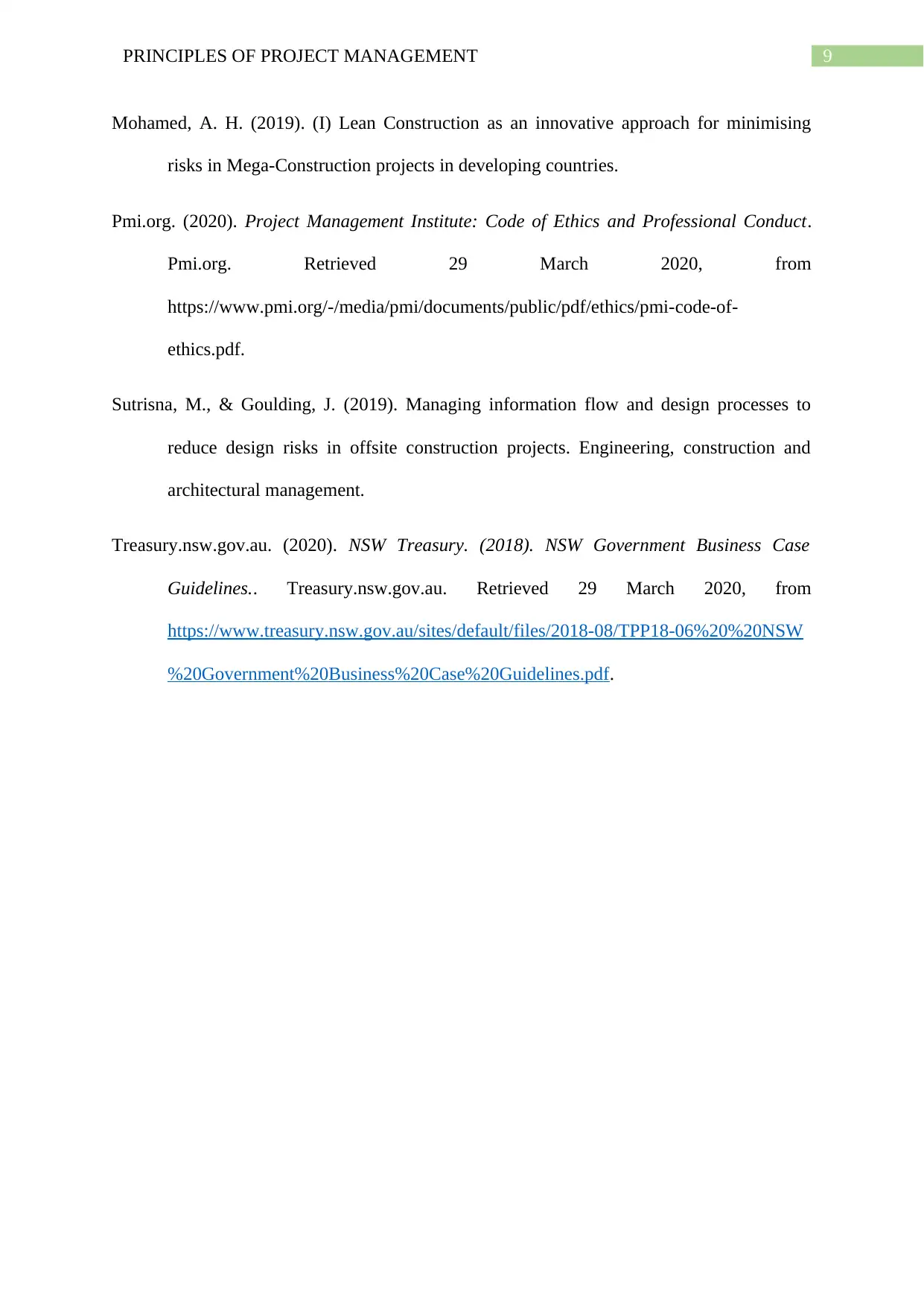
9PRINCIPLES OF PROJECT MANAGEMENT
Mohamed, A. H. (2019). (I) Lean Construction as an innovative approach for minimising
risks in Mega-Construction projects in developing countries.
Pmi.org. (2020). Project Management Institute: Code of Ethics and Professional Conduct.
Pmi.org. Retrieved 29 March 2020, from
https://www.pmi.org/-/media/pmi/documents/public/pdf/ethics/pmi-code-of-
ethics.pdf.
Sutrisna, M., & Goulding, J. (2019). Managing information flow and design processes to
reduce design risks in offsite construction projects. Engineering, construction and
architectural management.
Treasury.nsw.gov.au. (2020). NSW Treasury. (2018). NSW Government Business Case
Guidelines.. Treasury.nsw.gov.au. Retrieved 29 March 2020, from
https://www.treasury.nsw.gov.au/sites/default/files/2018-08/TPP18-06%20%20NSW
%20Government%20Business%20Case%20Guidelines.pdf.
Mohamed, A. H. (2019). (I) Lean Construction as an innovative approach for minimising
risks in Mega-Construction projects in developing countries.
Pmi.org. (2020). Project Management Institute: Code of Ethics and Professional Conduct.
Pmi.org. Retrieved 29 March 2020, from
https://www.pmi.org/-/media/pmi/documents/public/pdf/ethics/pmi-code-of-
ethics.pdf.
Sutrisna, M., & Goulding, J. (2019). Managing information flow and design processes to
reduce design risks in offsite construction projects. Engineering, construction and
architectural management.
Treasury.nsw.gov.au. (2020). NSW Treasury. (2018). NSW Government Business Case
Guidelines.. Treasury.nsw.gov.au. Retrieved 29 March 2020, from
https://www.treasury.nsw.gov.au/sites/default/files/2018-08/TPP18-06%20%20NSW
%20Government%20Business%20Case%20Guidelines.pdf.
Paraphrase This Document
Need a fresh take? Get an instant paraphrase of this document with our AI Paraphraser
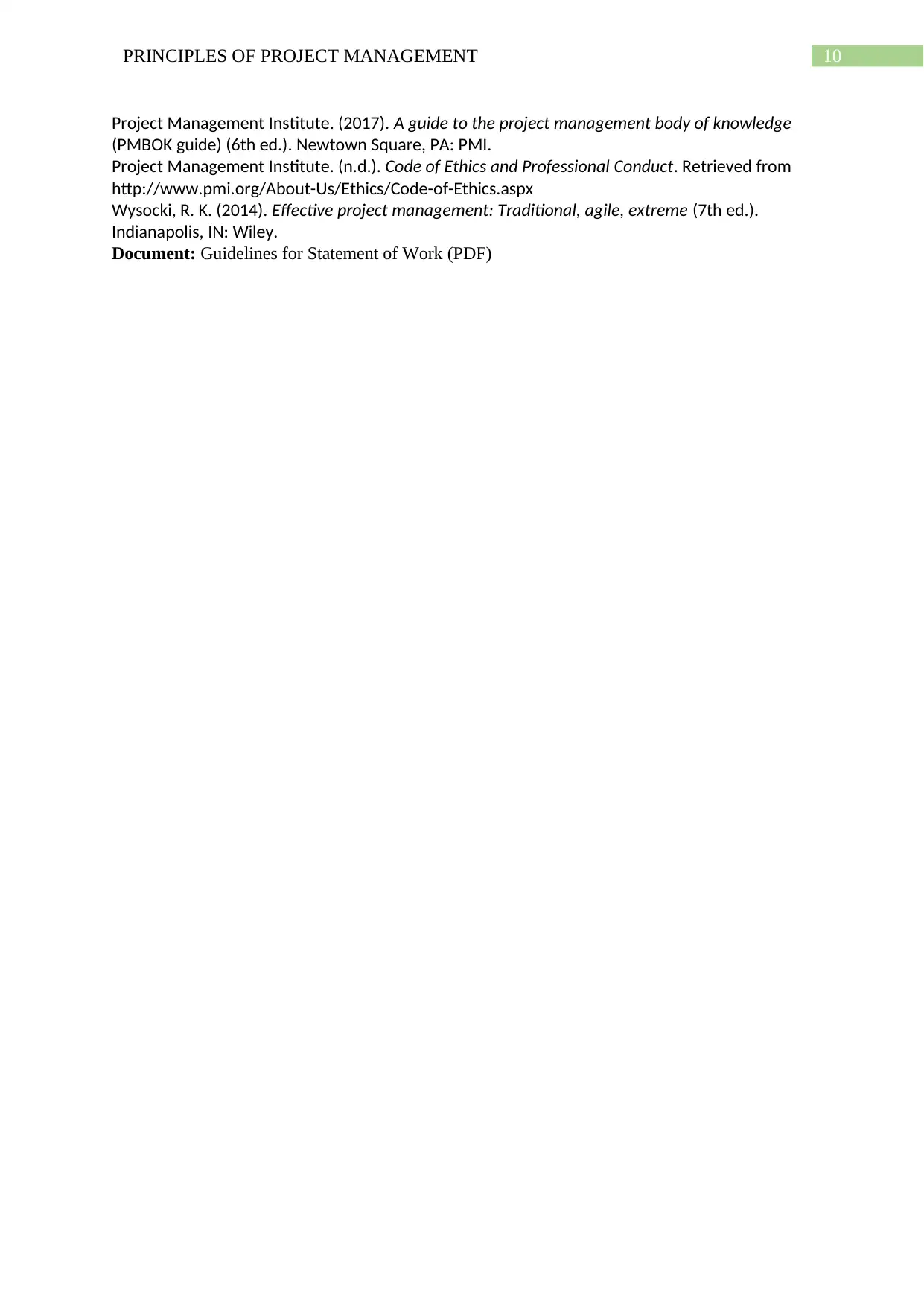
10PRINCIPLES OF PROJECT MANAGEMENT
Project Management Institute. (2017). A guide to the project management body of knowledge
(PMBOK guide) (6th ed.). Newtown Square, PA: PMI.
Project Management Institute. (n.d.). Code of Ethics and Professional Conduct. Retrieved from
http://www.pmi.org/About-Us/Ethics/Code-of-Ethics.aspx
Wysocki, R. K. (2014). Effective project management: Traditional, agile, extreme (7th ed.).
Indianapolis, IN: Wiley.
Document: Guidelines for Statement of Work (PDF)
Project Management Institute. (2017). A guide to the project management body of knowledge
(PMBOK guide) (6th ed.). Newtown Square, PA: PMI.
Project Management Institute. (n.d.). Code of Ethics and Professional Conduct. Retrieved from
http://www.pmi.org/About-Us/Ethics/Code-of-Ethics.aspx
Wysocki, R. K. (2014). Effective project management: Traditional, agile, extreme (7th ed.).
Indianapolis, IN: Wiley.
Document: Guidelines for Statement of Work (PDF)
1 out of 11
Related Documents
Your All-in-One AI-Powered Toolkit for Academic Success.
+13062052269
info@desklib.com
Available 24*7 on WhatsApp / Email
![[object Object]](/_next/static/media/star-bottom.7253800d.svg)
Unlock your academic potential
Copyright © 2020–2025 A2Z Services. All Rights Reserved. Developed and managed by ZUCOL.





